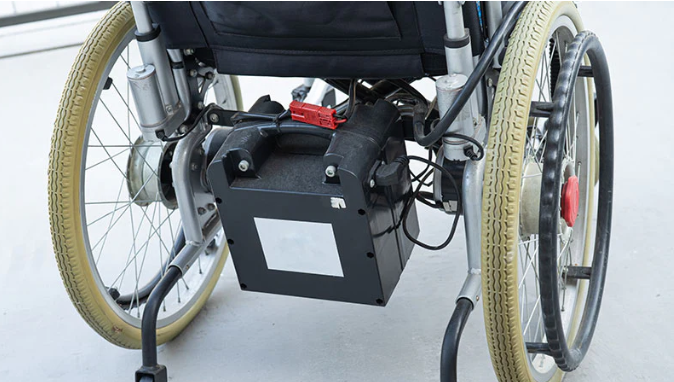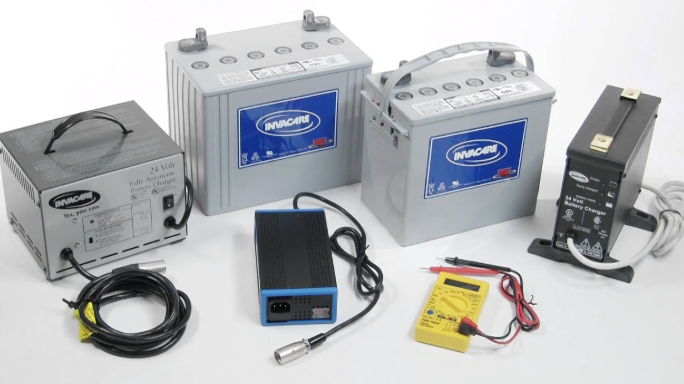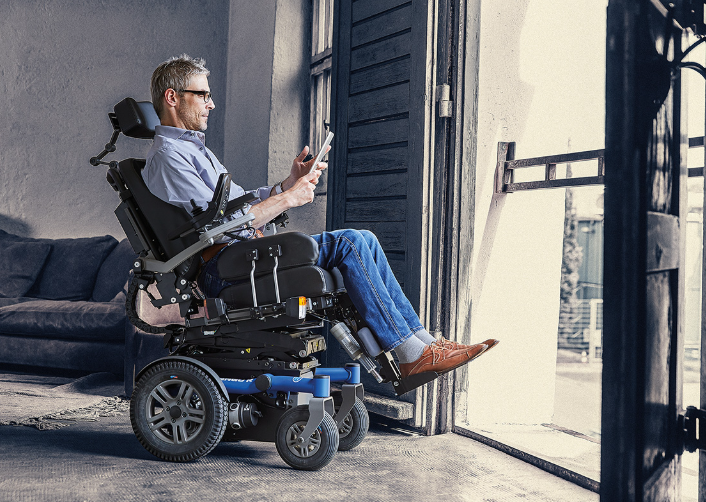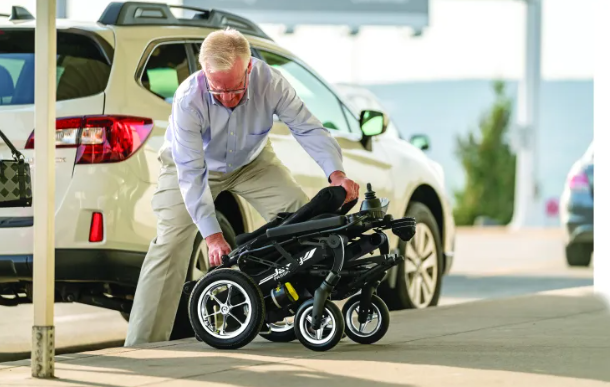How Many Batteries Does an Electric Wheelchair Have?
How many batteries does an electric wheelchair have? Most electric wheelchairs use one or two batteries. The number of batteries depends on the model and the amount of power needed to keep you moving.

Single Battery Systems
- One 12V battery
- Common in smaller, lightweight wheelchairs
- Often used in portable or travel models
- Best for indoor use or short distances
Dual Battery Systems
- Two 12V batteries connected in series to create a 24V system
- Found in larger, more powerful wheelchairs
- Provides more range and power output
- Ideal for outdoor use or rough terrain
High-Performance Systems
- Some heavy-duty models use four 12V batteries for a 48V system, though this is less common.
Battery Voltage and Configuration
Electric wheelchairs use a 24-volt system, powered by two 12-volt batteries working together. These batteries provide the power needed to keep your wheelchair moving smoothly. This system helps you stay mobile and independent. Think of it as the chair’s heart, giving it the energy to take you where you want to go.
Key Points About Battery Voltage and Configuration
Two 12V batteries in series create a 24V system.
Battery capacity is measured in ampere-hours (Ah). Most models range from 35Ah to 75Ah.
Bigger wheelchairs may need 36V or 48V systems, using three or four 12V batteries.
Lithium-ion batteries are getting more popular because they have a higher energy density.
A typical 24V system with 50Ah batteries can last about 30-40 miles on a full charge.
Examples of Common Configurations
2 x 12V 35Ah batteries = 24V 35Ah system
2 x 12V 55Ah batteries = 24V 55Ah system
3 x 12V 50Ah batteries = 36V 50Ah system (for higher-power models)
When replacing or upgrading, use batteries of the same type, capacity, and age to make sure the wheelchair works well and lasts longer.
Factors Affecting Battery Configuration
Wheelchair Type and Size
The type and size of the electric wheelchair affect its battery setup:
Lightweight indoor wheelchairs use a single 12V battery since they need less power.
Standard power wheelchairs use a 24V system with two 12V batteries to balance power and range.
Heavy-duty outdoor wheelchairs may have four 12V batteries (48V system) to handle rough terrain and extended use.
Power Requirements
The motor power determines the voltage system:
High-power motors need higher voltage, which usually requires more batteries.
A 24V system (2 x 12V batteries) is typical for most models, ensuring both efficiency and good performance.
Range Needs
Battery capacity affects the travel distance of the wheelchair:
Single battery systems provide a range of 5-10 miles per charge.
Dual battery setups extend the range to 15+ miles, perfect for users who need to travel longer distances.
User Weight
Heavier users demand more from the motor and battery system:
Increased weight requires more power, which may need extra batteries to maintain performance and range.
Usage Patterns
How often and where the wheelchair is used influences the battery setup:
Frequent use over long distances or rough terrain requires a multi-battery setup for consistent power.
Occasional or short-distance use may work well with a single battery system.
Battery Chemistry
The battery type affects how many are needed:
Lead-acid batteries require more batteries to achieve the same performance as lithium-ion batteries.
Lithium-ion batteries offer higher energy density, which may reduce the total number of batteries needed while still providing strong power.
Other Factors
Other things to consider:
Temperature – Cold weather can lower battery efficiency, requiring a larger setup.
Terrain – Uneven or steep surfaces use more power, affecting battery needs.
Accessories – Features like power seating, lights, and extra electronics may require additional battery capacity.
Types of Batteries Used
Electric wheelchairs use two main types of batteries:
Lead-acid batteries: These are the most common and traditional choice for electric wheelchairs.
Lithium-ion batteries: This newer option is growing in popularity due to its efficiency and lighter weight.

Battery Performance and Range
The range of an electric wheelchair per charge depends on the model and battery type:
Compact wheelchairs: Offer a range of 8-10 miles.
Mid-size wheelchairs: Have a range of 15-20 miles.
Heavy-duty wheelchairs: Can travel up to 25 miles on a single charge.
Factors Affecting Battery Life
Battery performance can be influenced by factors like:
User weight
Terrain
Temperature
Driving habits
Proper maintenance and charging practices can help extend the battery life and improve performance.
How Long Does an Electric Wheelchair Battery Last?
An electric wheelchair battery lasts between 1 and 3 years, depending on several factors. When fully charged, most batteries provide around 8-10 hours of use or 10-15 miles of travel.
Typical Lifespan by Battery Type
Sealed Lead-Acid: 1-2 years
Gel Cell: 1-2 years
Lithium-Ion: 2-3+ years
With proper care, the battery can last around 300-500 charge cycles before showing significant wear. High-capacity batteries can allow users to travel over 20 miles on a single charge, making them ideal for full-time use.
How Does an Electric Wheelchair Work?
An electric wheelchair is made up of several important parts that work together to provide mobility and control. Here’s how it all comes together:

Motors
Most electric wheelchairs use DC motors with reduction gears. These motors help the wheelchair move at low speeds with strong force. They are connected to the drive wheels, which are essential for the movement.
Batteries
Electric wheelchairs are powered by one or two rechargeable batteries. The common battery systems are 12V or 24V. Lithium-ion batteries are becoming popular because they are lighter and last longer. These batteries provide the power needed to run the motors and other electronics.
Controller
The controller interprets the user’s input. Whether you’re using a joystick or another device, the controller adjusts the power sent to the motors. It converts your actions into precise movements.
Drive System
Electric wheelchairs come with different drive configurations: – Rear-wheel drive: This provides stability and a smooth ride on flat surfaces. – Mid-wheel drive: Known for great maneuverability, especially in tight spaces. – Front-wheel drive: Offers more control on uneven surfaces, providing better stability.
Each configuration affects how the wheelchair handles different environments.
Wheels
The wheelchair usually has two large drive wheels, powered by the motors. It also has 2-4 smaller caster wheels to help keep the chair stable. The type and size of the wheels affect how the chair performs on different surfaces, like carpet, gravel, or smooth floors.
Frame
The frame is typically made from lightweight yet durable materials like aluminum or steel. It supports the user’s weight and all the components, providing both strength and portability.
Sensors
Many modern electric wheelchairs have sensors, such as Hall effect sensors and encoders. These sensors give feedback on the motor’s speed and position, allowing for more precise control and smoother operation.
Additional features often include adjustable speed settings, programmable controls, suspension systems for a smoother ride, and power seating functions like tilt, recline, and elevating leg rests for added comfort.
How far can an electric wheelchair go?
The range of an electric wheelchair on a single charge usually varies between 10 and 20 miles. Many factors affect how far the wheelchair can go before it needs to be recharged.
Range by model:
Basic models: 8-10 miles
Mid-range models: 15-20 miles
Premium models: 25-40 miles
Keep in mind, the real-world range is often 20-30% less than the maximum stated by the manufacturer due to these factors.
How Heavy Is an Electric Wheelchair with Batteries?
Electric wheelchairs weigh between 50-250 pounds when the batteries are installed. The exact weight depends on the model and features.

Weight Ranges by Model
Lightweight folding power wheelchairs: 40-70 pounds with battery
Standard power wheelchairs: 100-200 pounds with batteries
Heavy-duty power wheelchairs: 200-350 pounds with batteries
Battery Weight
Batteries typically weigh between 20-50 pounds for a pair of 12V batteries. Lithium-ion batteries are lighter and usually weigh 2-5 pounds each.
Examples of Wheelchair Weights
Grace Medy lightweight foldable electric wheelchair: 33 pounds
Vive Deluxe folding power wheelchair: 67.8 pounds
GoRide electric wheelchair: 39 pounds (with 24V 6Ah battery)
RAGER power chair: 40 pounds
Factors Affecting the Total Weight
Frame material: Aluminum is lighter than steel.
Battery type and capacity: Larger batteries are heavier.
Motor size: More powerful motors add weight.
Additional features: Features like tilt/recline systems can increase weight.
Seat size and padding: Larger or cushioned seats add extra weight.
Removing the batteries can reduce the wheelchair’s weight by 20-50 pounds, making it easier to transport.
Summary
Understanding how many batteries your electric wheelchair needs is important for getting the best performance and range. If you’re looking for a lightweight, portable model or a heavy-duty chair for outdoor use, knowing your power requirements will help you make the right choice. With technology improving, the future of electric wheelchairs is looking better. We can expect more efficient, reliable, and easy-to-use options for greater mobility and independence.
